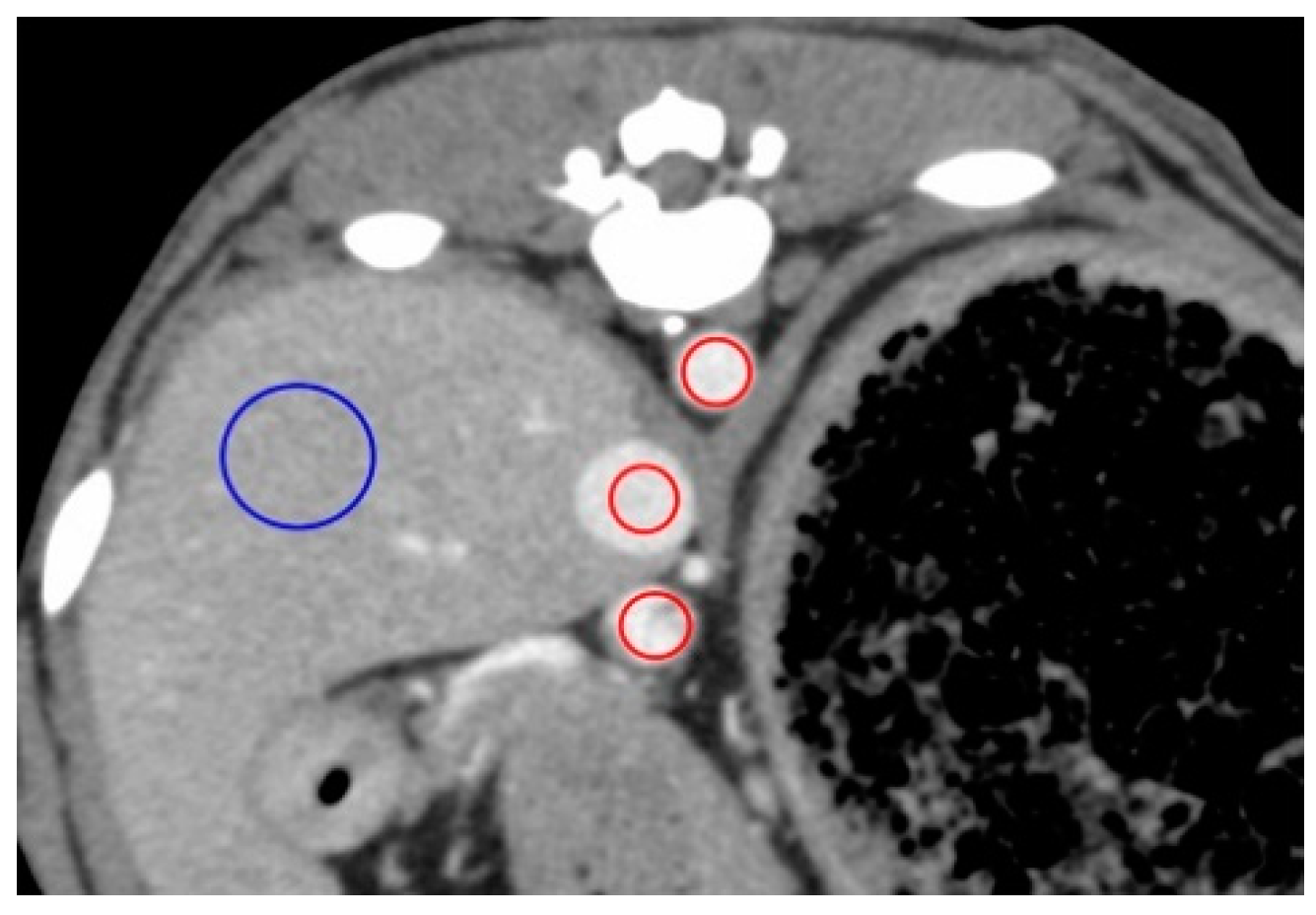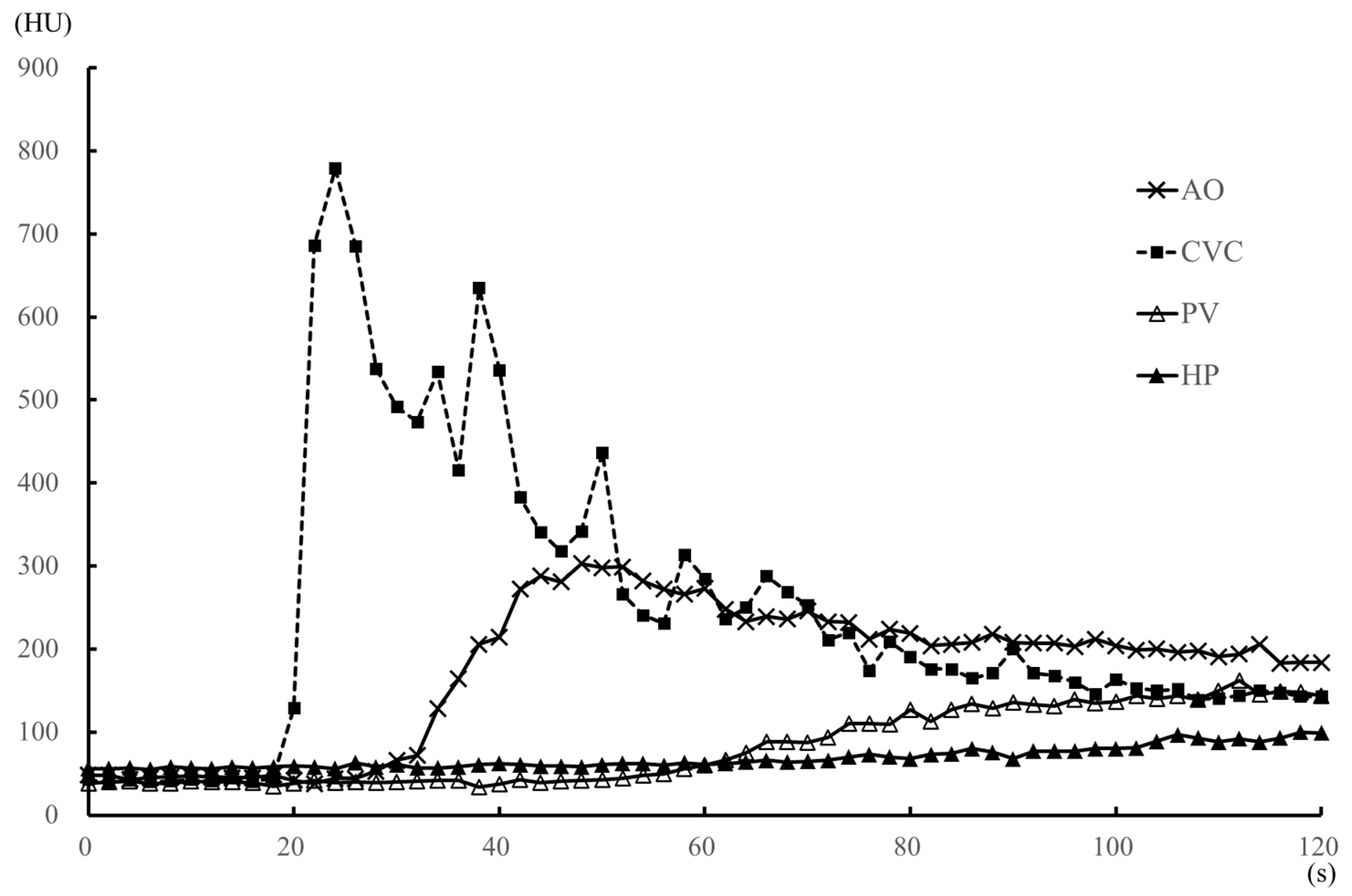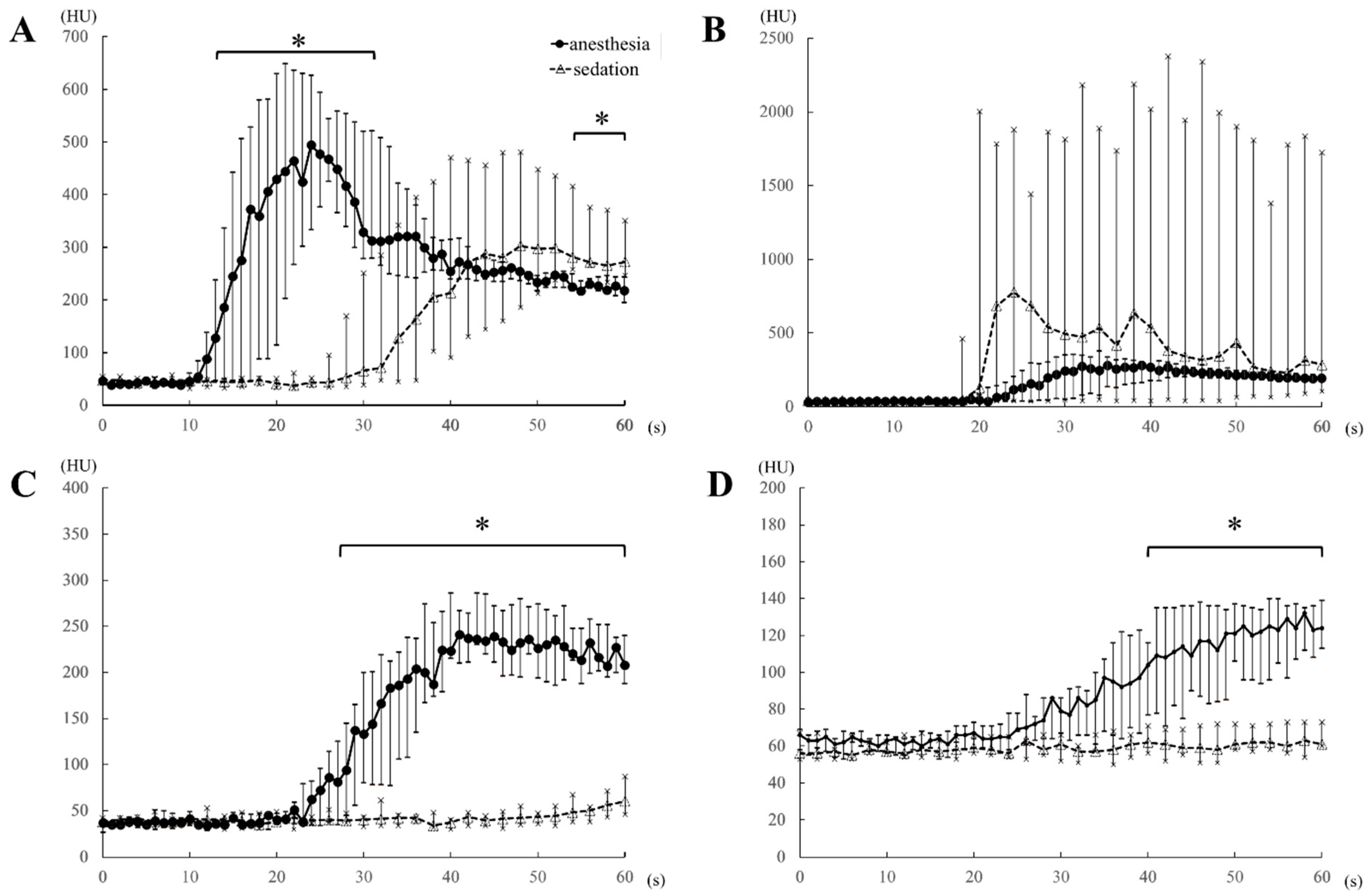Effects of Sedation by Intramuscular Administration of Medetomidine on Canine Abdominal Vascular System and Hepatic Parenchyma Imaging Using Enhancement Dynamic Computed Tomography
Abstract
:1. Introduction
2. Materials and Methods
2.1. Anesthesia and Sedation Protocols
2.2. CT Imaging Protocol
2.3. Image Analysis
2.4. Statistical Analysis
3. Results
4. Discussion
5. Conclusions
Author Contributions
Funding
Conflicts of Interest
References
- Fukushima, K.; Kanemoto, H.; Ohno, K.; Takahashi, M.; Fujiwara, R.; Nishimura, R.; Tsujimoto, H. Computed Tomographic Morphology and Clinical Features of Extrahepatic Portosystemic Shunts in 172 Dogs in Japan. Vet. J. 2014, 199, 376–381. [Google Scholar] [CrossRef] [PubMed]
- Zwingenberger, A.L.; Schwarz, T. Dual-Phase CT Angiography of the Normal Canine Portal and Hepatic Vasculature. Vet. Radiol. Ultrasound. 2004, 45, 117–124. [Google Scholar] [CrossRef] [PubMed]
- Kirberger, R.M.; Cassel, N.; Stander, N.; McLean, M.; Dvir, E. Triple Phase Dynamic Computed Tomographic Perfusion Characteristics of Spirocercosis Induced Esophageal Nodules in Non-Neoplastic Versus Neoplastic Canine Cases. Vet. Radiol. Ultrasound. 2015, 56, 257–263. [Google Scholar] [CrossRef] [PubMed] [Green Version]
- Fukushima, K.; Kanemoto, H.; Ohno, K.; Takahashi, M.; Nakashima, K.; Fujino, Y.; Uchida, K.; Fujiwara, R.; Nishimura, R.; Tsujimoto, H. CT Characteristics of Primary Hepatic Mass Lesions in Dogs. Vet. Radiol. Ultrasound. 2012, 53, 252–257. [Google Scholar] [CrossRef] [PubMed]
- Kutara, K.; Seki, M.; Ishikawa, C.; Sakai, M.; Kagawa, Y.; Iida, G.; Ishigaki, K.; Teshima, K.; Edamura, K.; Nakayama, T.; et al. Triple-Phase Helical Computed Tomography in Dogs with Hepatic Masses. Vet. Radiol. Ultrasound. 2014, 55, 7–15. [Google Scholar] [CrossRef]
- Kutara, K.; Seki, M.; Ishigaki, K.; Teshima, K.; Ishikawa, C.; Kagawa, Y.; Edamura, K.; Nakayama, T.; Asano, K. Triple-Phase Helical Computed Tomography in Dogs with Solid Splenic Masses. J. Vet. Med. Sci. 2017, 79, 1870–1877. [Google Scholar] [CrossRef] [PubMed] [Green Version]
- Leela-Arporn, R.; Ohta, H.; Shimbo, G.; Hanazono, K.; Osuga, T.; Morishita, K.; Sasaki, N.; Takiguchi, M. Computed Tomographic Features for Differentiating Benign From Malignant Liver Lesions in Dogs. J. Vet. Med. Sci. 2019, 81, 1697–1704. [Google Scholar] [CrossRef] [Green Version]
- Yoshida, O.; Kutara, K.; Seki, M.; Ishigaki, K.; Teshima, K.; Ishikawa, C.; Iida, G.; Edamura, K.; Kagawa, Y.; Asano, K. Preoperative Differential Diagnosis of Canine Adrenal Tumors Using Triple-Phase Helical Computed Tomography. Vet. Surg. 2016, 45, 427–435. [Google Scholar] [CrossRef]
- Fukushima, K.; Fujiwara, R.; Yamamoto, K.; Kanemoto, H.; Ohno, K.; Tsuboi, M.; Uchida, K.; Matsuki, N.; Nishimura, R.; Tsujimoto, H. Characterization of Triple-Phase Computed Tomography in Dogs with Pancreatic Insulinoma. J. Vet. Med. Sci. 2016, 77, 1549–1553. [Google Scholar] [CrossRef] [Green Version]
- Buishand, F.O.; Vilaplana Grosso, F.R.; Kirpensteijn, J.; van Nimwegen, S.A. Utility of Contrast-Enhanced Computed Tomography in the Evaluation of Canine Insulinoma Location. Vet. Q. 2018, 38, 53–62. [Google Scholar] [CrossRef] [Green Version]
- French, J.M.; Twedt, D.C.; Rao, S.; Marolf, A.J. Computed Tomographic Angiography and Ultrasonography in the Diagnosis and Evaluation of Acute Pancreatitis in Dogs. J. Vet. Intern. Med. 2019, 33, 79–88. [Google Scholar] [CrossRef]
- French, J.M.; Twedt, D.C.; Rao, S.; Marolf, A.J. CT Angiographic Changes in Dogs With Acute Pancreatitis: A Prospective Longitudinal Study. Vet. Radiol. Ultrasound. 2020, 61, 33–39. [Google Scholar] [CrossRef]
- Lee, S.K.; Lee, D.; Kim, D.; Cha, A.; Choi, J. Effect of Catheter Size and Injection Rate of Contrast Agent on Enhancement and Image Quality for Triple-Phase Helical Computed Tomography of the Liver in Small Dogs. Vet. Radiol. Ultrasound. 2017, 58, 664–670. [Google Scholar] [CrossRef]
- Kishimoto, M.; Yamada, K.; Tsuneda, R.; Shimizu, J.; Iwasaki, T.; Miyake, Y.I. Effect of Contrast Media Formulation on Computed Tomography Angiographic Contrast Enhancement. Vet. Radiol. Ultrasound. 2008, 49, 233–237. [Google Scholar] [CrossRef] [PubMed]
- Choi, S.Y.; Lee, I.; Seo, J.W.; Park, H.Y.; Choi, H.J.; Lee, Y.W. Optimal Scan Delay Depending on Contrast Material Injection Duration in Abdominal Multi-Phase Computed Tomography of Pancreas and Liver in Normal Beagle Dogs. J. Vet. Sci. 2016, 17, 555–561. [Google Scholar] [CrossRef] [PubMed]
- Shanaman, M.M.; Hartman, S.K.; O’Brien, R.T. Feasibility for Using Dual-Phase Contrast-Enhanced Multi-Detector Helical Computed Tomography to Evaluate Awake and Sedated Dogs with Acute Abdominal Signs. Vet. Radiol. Ultrasound. 2012, 53, 605–612. [Google Scholar] [CrossRef] [PubMed]
- Fields, E.L.; Robertson, I.D.; Brown, J.C., Jr. Optimization of Contrast-Enhanced Multidetector Abdominal Computed Tomography in Sedated Canine Patients. Vet. Radiol. Ultrasound. 2012, 53, 507–512. [Google Scholar] [CrossRef]
- Lemke, K.A. Anticholinergics and Sedatives. In Lumb & Jones’ Veterinary Anesthesia and Analgesia, 4th ed.; Tranquilli, W.J., Thurmom, J.C., Crimm, K.A., Eds.; Blackwell: Ames, IA, USA, 2007; pp. 203–240. [Google Scholar]
- Rand, J.S.; Reynolds, W.T.; Proest, J. Echocardiographic Evaluation of the Effects of Medetomidine and Xylazine in Dogs. Aust. Vet. J. 1996, 73, 41–44. [Google Scholar] [CrossRef]
- Miño, N.; Espino, L.; Barreiro, A. Effects of Medetomidine on Doppler Variables of Major Abdominal Arteries in Normal Dogs. Vet. Res. Commun. 2008, 32, 175–186. [Google Scholar] [CrossRef]
- Pienn, M.; Kovacs, G.; Tscherner, M.; Johnson, T.R.; Kullnig, P.; Stollberger, R.; Olschewski, A.; Olschewski, H.; Bálint, Z. Determination of Cardiac Output with Dynamic Contrast-Enhanced Computed Tomography. Int. J. Cardiovasc. Imaging 2013, 29, 1871–1878. [Google Scholar] [CrossRef] [PubMed]
- Masuda, T.; Nakaura, T.; Funama, Y.; Higaki, T.; Kiguchi, M.; Imada, N.; Sato, T.; Awai, K. Aortic and Hepatic Contrast Enhancement during Hepatic-Arterial and Portal Venous Phase Computed Tomography Scanning: Multivariate Linear Regression Analysis Using Age, Sex, Total Body Weight, Height, and Cardiac Output. J. Comput. Assist. Tomogr. 2017, 41, 309–314. [Google Scholar] [CrossRef] [PubMed]
- Ko, J.C.; Bailey, J.E.; Pablo, L.S.; Heaton-Jones, T.G. Comparison of sedative and cardiorespiratory effects of medetomidine and medetomidine-butorphanol combination in dogs. Am. J. Vet. Res. 1996, 57, 535–540. [Google Scholar] [CrossRef]
- Hayashi, K.; Nishimura, R.; Yamaki, A.; Kim, H.; Matsunaga, S.; Sasaki, N.; Takeuchi, A. Comparison of sedative effects induced by medetomidine, medetomidine-midazolam and medetomidine-butorphanol in dogs. J. Vet. Med. Sci. 1994, 56, 951–956. [Google Scholar] [CrossRef] [Green Version]
- Pypendop, B.H.; Verstegen, J.P. Hemodynamic effects of medetomidine in the dog: A dose titration study. Vet. Surg. 1998, 27, 612–622. [Google Scholar] [CrossRef]
- Bezuidenbout, A.J. Veins. In Miller’s Anatomy of the Dog, 4th ed.; Lauhunta, E.D., Ed.; Elsevier Saunders: St Louis, MO, USA, 2013; pp. 504–534. [Google Scholar]
- Evans, H.E.; Lauhunta, E.D. The Digestive Apparatus and Abdomen. In Miller’s Anatomy of the Dog, 4th ed.; Lauhunta, E.D., Ed.; Elsevier Saunders: St Louis, MO, USA, 2013; pp. 281–337. [Google Scholar]
- Sullivan, I.W.; Hota, P.; Dako, F.; Hajdinaj, S.; Davila, B. Dependent Layering of Venous Refluxed Contrast: A Sign of Critically Low Cardiac Output. Radiol. Case. Rep. 2018, 14, 230–234. [Google Scholar] [CrossRef] [PubMed]
- Tsai, P.P.; Chen, J.H.; Huang, J.L.; Shen, W.C. Dependent Pooling: A Contrast-Enhanced Sign of Cardiac Arrest During CT. AJR. Am. J. Roentgenol. 2002, 178, 1095–1099. [Google Scholar] [CrossRef] [PubMed]
- Roth, C.; Sneider, M.; Bogot, N.; Todd, M.; Cronin, P. Dependent Venous Contrast Pooling and Layering: A Sign of Imminent Cardiogenic Shock. AJR. Am. J. Roentgenol. 2006, 186, 1116–1119. [Google Scholar] [CrossRef] [PubMed]





| Parameters | Anesthesia Protocol | Sedation Protocol | p-Value |
|---|---|---|---|
| AO–EA (s) * | 13 (12–18) | 30 (26–38) | 0.012 |
| AO–EP (s) * | 24 (21–31) | 48 (40–58) | 0.013 |
| Peak contrast value of AO (HU) * | 558.3 (494.7–648.3) | 343.1 (289.2–481.7) | 0.012 |
| CVC–EA (s) | 21 (20–32) | 20 (18–50) | 0.526 |
| CVC–EP (s) | 37 (34–45) | 40 (24–74) | 1 |
| Peak contrast value of CVC (HU) | 313.5 (228.1–381.4) | 779.6 (154.2–2375.6) | 0.144 |
| PV–EA (s) * | 25 (24–30) | 64 (54–78) | 0.012 |
| PV–EP (s) * | 43 (41–44) | 104 (90–180) | 0.011 |
| Peak contrast value of PV (HU) * | 244.4 (236.2–285.9) | 166.3 (162.1–199.3) | 0.012 |
| HP–EA (s) * | 25 (18–35) | 50 (42–94) | 0.012 |
| HP–EP (s) * | 56 (51–60) | 240 (108–240) | 0.012 |
| Peak contrast value of HP (HU) * | 132.4 (127.5–132.8) | 111.4 (106.7–125.2) | 0.012 |
| Parameters | 0 min | 1 min | 2 min | 3 min | 4 min | 5 min |
|---|---|---|---|---|---|---|
| the contrast values of AO; anesthesia protocol (HU) | 46.1 (42.8–48.9) | 218.7 (195.8–244.6) | 174.6 (157.3–199.8) | 141.2 (129.8–184.6) | 127.4 (119.7–158.2) | 122.2 (110.5–147.5) |
| the contrast values of AO; sedation protocol (HU) | 48.2 (47.4–55.3) | 273.6 (247.2–351.4) | 184.3 (144.3–232.1) | 146.3 (137.6–157.8) | 131.6 (109.2–133.8) | 123.4 (98.3–141.1) |
| p value | 0.073 | 0.012 * | 0.835 | 0.463 | 0.833 | 0.834 |
| the contrast values of CVC; anesthesia protocol (HU) | 32.8 (30.9–41.5) | 195.4 (177.7–215.7) | 159.5 (142.0–184.3) | 131.5 (109.8–159.1) | 122.1 (113.5–145.2) | 111.9 (100.9–127.6) |
| the contrast values of CVC; sedation protocol (HU) | 43.3 (34.1–45.2) | 285.3 (104.4–1722.1) | 143.5 (118.2–357.0) | 117.6 (88.8–144.7) | 108.5 (94.4–114.4) | 100.6 (81.9–104.4) |
| p value | 0.142 | 0.675 | 0.296 | 0.296 | 0.356 | 0.096 |
| the contrast values of PV; anesthesia protocol (HU) | 37.6 (27.3–29.4) | 208.1 (188.8–240.0) | 175.4 (161.2–216.7) | 139.4 (127.4–187.1) | 125.5 (117.4–161.4) | 118.5 (112.1–137.4) |
| the contrast values of PV; sedation protocol (HU) | 38.2 (37.4–42.8) | 60.3 (46.2–87.6) | 144.5 (142.6–178.9) | 142.4 (123.3–166.4) | 137.8 (118.4–147.2) | 122.0 (99.7–136.8) |
| p value | 0.142 | 0.012 * | 0.142 | 1 | 0.531 | 0.676 |
| the contrast values of HP; anesthesia protocol (HU) | 66.2 (58.4–69.1) | 124.8 (113.1–139.0) | 122.2 (111.7–129.4) | 111.1 (102.0–114.8) | 107.6 (96.5–111.7) | 98.4 (93.3–113.8) |
| the contrast values of HP; sedation protocol (HU) | 56.1 (53.2–67.4) | 61.2 (60.0–78.1) | 99.3 (77.1–112.0) | 107.8 (104.7–120.2) | 111.4 (98.4–125.1) | 110.4 (97.8–119.6) |
| p value | 0.143 | 0.012 * | 0.021 * | 0.917 | 0.142 | 0.173 |
| Group | Heart Rate before Procedure | Heart Rate of 0 min (bpm) | Heart Rate of 1 min (bpm) | Heart Rate of 2 min (bpm) | Heart Rate of 3 min (bpm) | Heart Rate of 4 min (bpm) | Heart Rate of 5 min (bpm) |
|---|---|---|---|---|---|---|---|
| anesthesia protocol | 100 (140–83) | 103 (78–136) | 101 (76–131) | 102 (79–126) | 101 (73–127) | 103 (71–124) | 103 (68–122) |
| sedation protocol | 108 (138–85) | 44 (40–48) ** | 40 (36–44) ** | 36 (28–44) ** | 44 (36–48) ** | 40 (36–48) ** | 44 (36–44) ** |
| p-value | 1 | 0.012 * | 0.012 * | 0.012 * | 0.012 * | 0.011 * | 0.011 * |
| Group | The Point of before Protocol Procedure | The Point of Start of Scan | ||||
|---|---|---|---|---|---|---|
| SAP (mmHg) | DAP (mmHg) | MAP (mmHg) | SAP (mmHg) | DAP (mmHg) | MAP (mmHg) | |
| anesthesia protocol | 160 (138–212) | 110 (109–138) | 124 (106–148) | 91 (88–108) ** | 50 (38–62) ** | 64 (62–84) ** |
| sedation protocol | 156 (134–170) | 94 (88–129) | 107 (100–138) | 147 (129–170) | 101 (96–124) | 124 (111–144) |
| p-value | 0.835 | 0.593 | 0.403 | 0.012 * | 0.012 * | 0.012 * |
© 2020 by the authors. Licensee MDPI, Basel, Switzerland. This article is an open access article distributed under the terms and conditions of the Creative Commons Attribution (CC BY) license (http://creativecommons.org/licenses/by/4.0/).
Share and Cite
Kutara, K.; Kanda, T.; Maeta, N.; Mochizuki, Y.; Itoh, Y.; Ono, F.; Asanuma, T. Effects of Sedation by Intramuscular Administration of Medetomidine on Canine Abdominal Vascular System and Hepatic Parenchyma Imaging Using Enhancement Dynamic Computed Tomography. Vet. Sci. 2020, 7, 91. https://doi.org/10.3390/vetsci7030091
Kutara K, Kanda T, Maeta N, Mochizuki Y, Itoh Y, Ono F, Asanuma T. Effects of Sedation by Intramuscular Administration of Medetomidine on Canine Abdominal Vascular System and Hepatic Parenchyma Imaging Using Enhancement Dynamic Computed Tomography. Veterinary Sciences. 2020; 7(3):91. https://doi.org/10.3390/vetsci7030091
Chicago/Turabian StyleKutara, Kenji, Teppei Kanda, Noritaka Maeta, Yohei Mochizuki, Yoshiki Itoh, Fumiko Ono, and Taketoshi Asanuma. 2020. "Effects of Sedation by Intramuscular Administration of Medetomidine on Canine Abdominal Vascular System and Hepatic Parenchyma Imaging Using Enhancement Dynamic Computed Tomography" Veterinary Sciences 7, no. 3: 91. https://doi.org/10.3390/vetsci7030091





